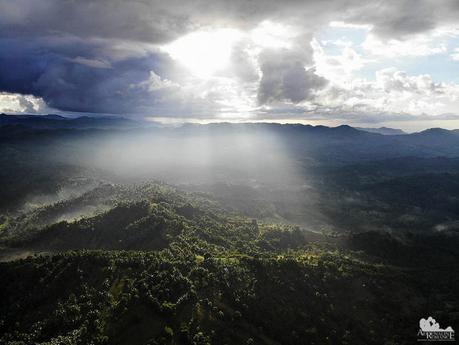
In the blockbuster movie Back to the Future, both Marty and his father George McFly said, “If you put your mind to it, you can accomplish anything.” Well, one of our goals is to take an arduous but scenic long-distance trek that spans hundreds of kilometers. Finishing even a quarter of that trek gives us the inspiration to go on, reinforcing the idea that completing the trail can be done. Well, that was exactly what happened when we finished Segment 2 of the Cebu Highlands Trail.
The refreshing bath, the delicious food, the cool weather, and the sheltered chapel all worked in sync to make us pleasantly sleepy after an exhausting 20-kilometer trek. After a very comfortable, almost home-like sleep inside the chapel, we woke up to a beautiful day. Although we could not see the rising sun, its sunbeams formed orange coronas on the clouds. Early in the morning, Nature wakes up and starts painting the sky. In virtually all our outdoor adventures, we strive to wake up early so we could see that painting.
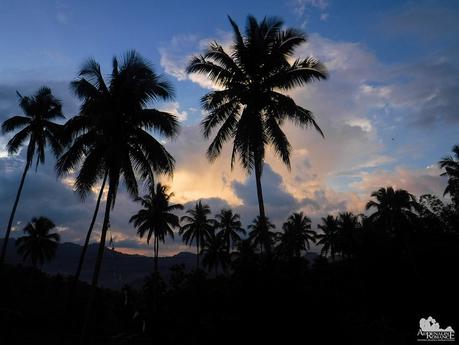
While we prepared breakfast, Halourd went out to give his new Mavic Air a stretch. And oh boy, did he take amazing aerial photos! Now we could see what the landscape looks like in the eyes of an eagle. Sir Jing remarked that his work in establishing the CHT could have been easier if he can see like this. Hehehe!
But just look at this photo of the green valleys and mountains of San Fernando. Stunning, isn’t it? That’s Magsico Valley, San Fernando as seen from Tubod.
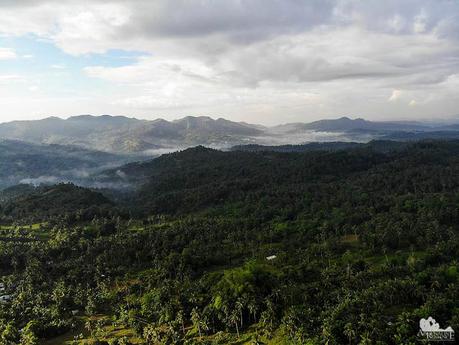
One of the nicest things about traveling is that when you least expect it, there’s always a silver lining that shines through the clouds.
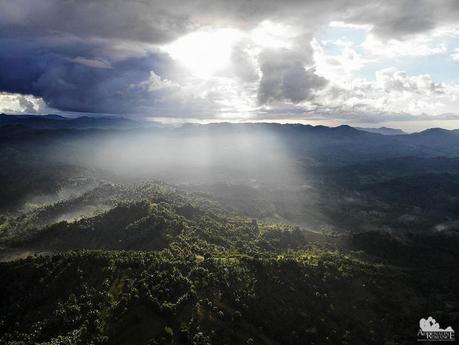
From several hundred feet up in the air, we could see the small barangay of Tubod. Notice how isolated this community is—it’s virtually surrounded by mountains, hills, and forests with only a single road that connects it with the rest of civilization.
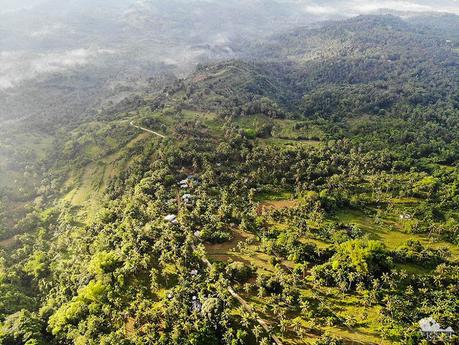
Can you see me? I’m the tiny guy in white on the pathway beside the chapel (building with a corrugated roof). Can you identify the other structures here? There’s a house, a farm, a basketball court, the covered communal pasong, and the barangay’s main road.
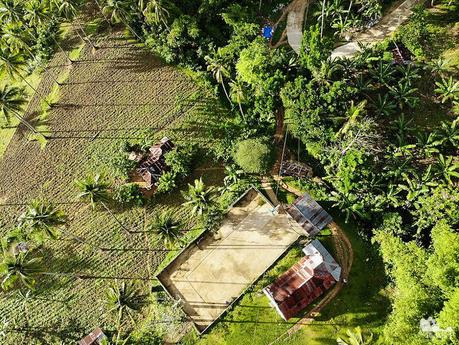
Breakfast bell! Ding ding! We ate a traditional Filipino breakfast of scrambled eggs, buwad potpot (fried dried fish), and tuna flakes. We ate a lot; we need a lot of energy for the day’s trek.
After a hearty breakfast, we borrowed a broom and thoroughly cleaned the chapel. Then we had a quick bath, packed up, and prepared for the next stage of Segment 2.

With our Deuter packs comfortably adjusted and strapped to our backs, we started the long trek to Barili, which is still three municipalities away. The cool morning breeze and the rural scenery were incredibly pleasant. In fact, we were in high spirits as we trudged along the rough road, knowing fully well that we’re going to be incredibly exhausted by the day’s end.
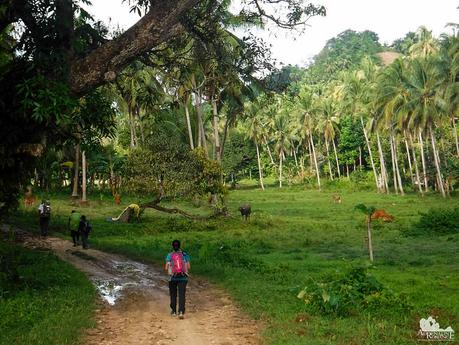
Most of the landscape in this part of Cebu is dominated by vast bocages similar to those in France and England. A bocage is a mixed terrain of farmlands, pastures, and woodland. Bocages are exceptionally scenic, especially when seen from a high elevation.

Among us, Apol was probably the happiest one. Like us, she’s an avid outdoorperson. However, a recent surgery forced her to go on a prolonged hiatus. The doctor advised her to take it easy on her activities. Yes, we could feel her desperation to go back into the wild.
This trek was her first time in the outdoors since that surgery. Undoubtedly, Apol felt incredibly refreshed and relieved upon returning to her playground.
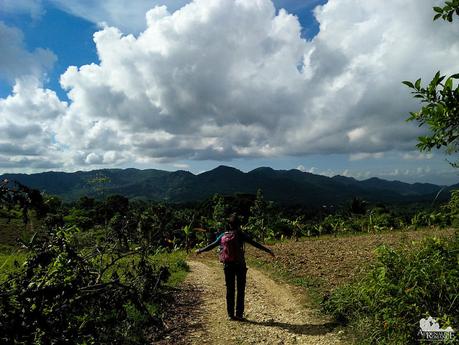
Seemingly never-ending ranges of mountains snake along the length of Cebu. Almost invisible in the province’s economic and social radar are specks of civilization nestled between these ranges.
But don’t underestimate the locals in these far-strung communities. They are happier, less stressed, and more hardworking than their urban counterparts.
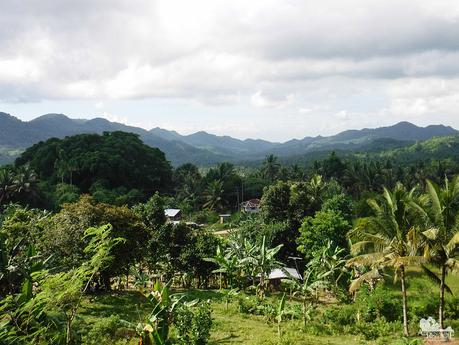
Walls of palm trees lined either side of the road akin to soldiers raising their sabers to salute five weary visitors.
Palm trees like these are ubiquitous in the countrysides. Locals use every part of the palm tree for anything—the trunk for lumber, the nuts for food, the palm leaves for roofs and weaved products, and more.
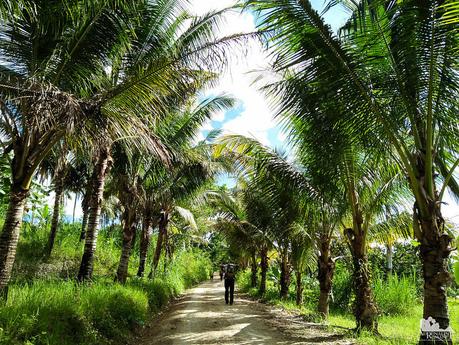
Everyday scenes of rural life are uplifting and enlightening. They transport you back to the days when life was so much simpler. Experiencing countryside life first-hand makes us reflect on just how far we, as a society, have developed, for better or for worse. Trekking the CHT allows us to open our eyes and minds to another aspect of Cebuano culture that is so near yet so isolated.
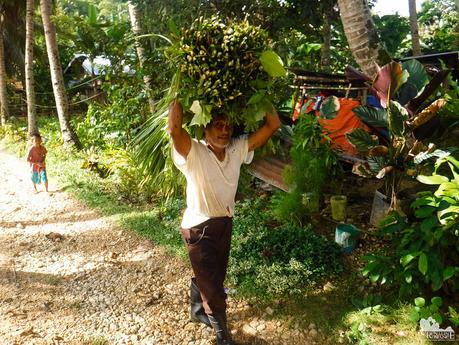
In the countryside, carabaos are more than just living tractors. Farmers consider them as pets and members of the family.
In the countryside, carabao services are also a medium of exchange. A lot of farmers are financially impoverished, so they resort to barter. The carabao owner agrees to let the farmer use the animal to plow the latter’s fields. In return, the farmer gives the carabao owner a part of his harvest.
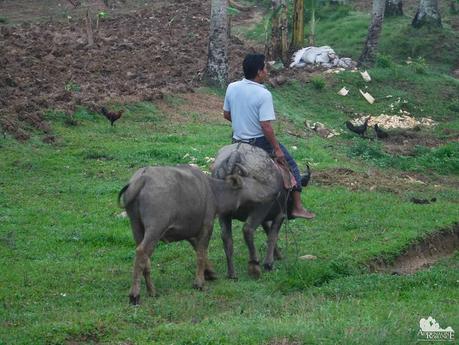
Carabaos are not mechanical tractors—although their enormous strength and preternatural endurance can almost qualify them as such. They are living beings like us, and thus, they have their own versions of happiness. For this one, it’s using a small roadside pool as a bathtub to cool off from a hot morning.
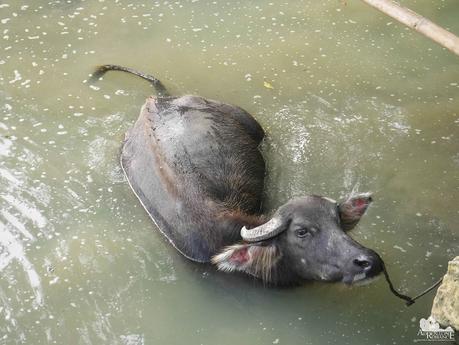
Several miles away near the border between the municipalities of San Fernando and Carcar, we took a break in the form of homemade ice candies (ice Popsicle made of sweetened milk and coconut water). While enjoying the ice candies, we saw this small puppy visibly shivering. His owner (the little girl in the photo below) gave him a bath, and he sure doesn’t like it. Hahaha!
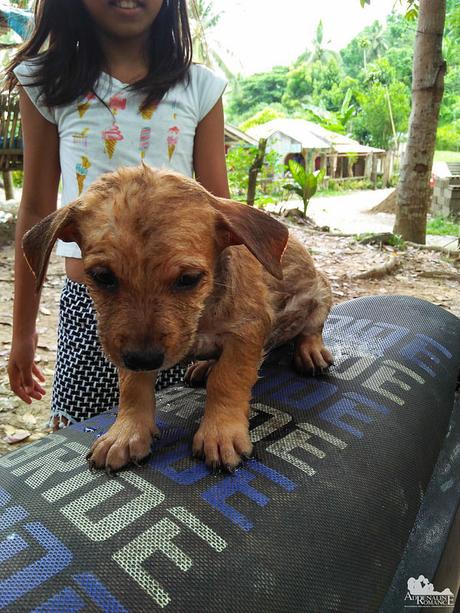
Local kids asked us if we could take their photos. Their idea of fun was simple: climb a tree, snack on the fruits, or play hide-and-seek within the foliage. These kids can definitely find happiness without expensive gadgets, televisions, money, or the need to be accepted by society.
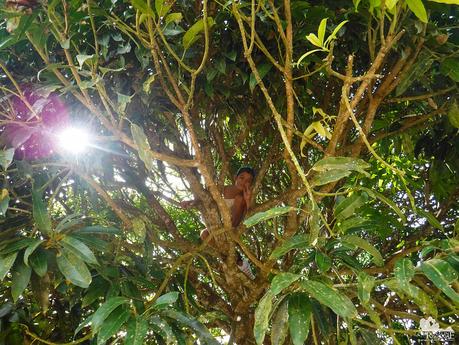
The morning sun burned the land as it rose higher in the sky. By 11 AM, walking became a horrible torture. The road was almost radioactive; there was no escape from the intense heat.
Fortunately, in many places, there were lots of towering trees that provide significant shade. We usually kept to the side of the road, staying in the refuge of whatever small shadow we can find. Hahaha!
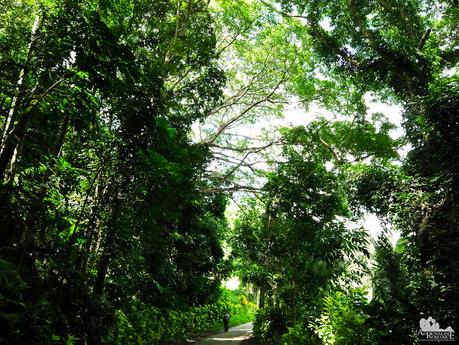
A little past 12 noon, we finally arrived at Barangay Calindang, which is at the junction between the southern and western areas of Cebu island. We found a large carenderia offering hot, delicious, and freshly cooked meals. That’s about time! We believe the calories we had after our heavy breakfast simply evaporated in the heat after miles upon miles of trekking!
We had steaming tinola (fish broth), spicy dinuguan (pork blood stew), sauteed vegetables, and some fried chicken we prepared as an emergency lunch in case we won’t be able to reach this junction by midday.
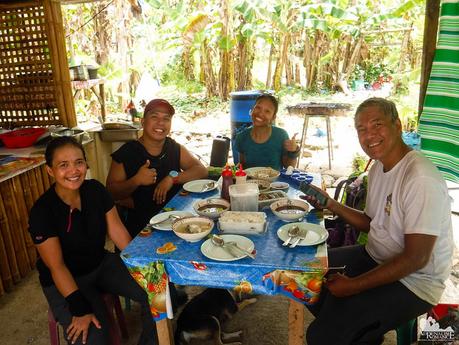
Sir Jing allowed us to take a one-hour break in a roadside shed that served as a resting place for waiting habal-habal drivers. But we couldn’t stay long because we had to keep moving so we could follow our itinerary.
Again, we walked along the highway. At high noon. Under the sun’s unceasing full power.
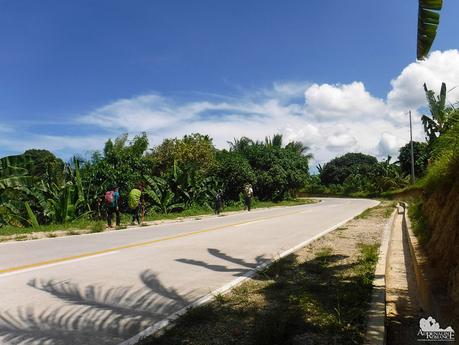
Tiring as it may be, it was a great walk. The lovely scenery all over us was a balm. We usually witness these mountain scenes behind the window of a moving bus. But walking slowly beside these vistas is a different experience. We felt a closer connection and a deeper reverence for the countryside as we toiled.
Far away, we could hear the faint roils of thunder. We silently hoped that rain will overtake us; we needed a refreshing shower!
Tip: Walking on a concrete road can be quite painful to your feet. So try walking on the soft, uneven ground beside the road. The softer terrain is easier on your feet.
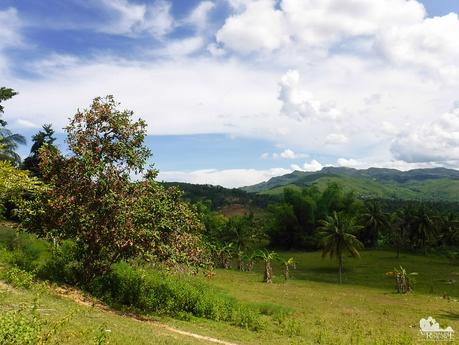
To replenish our ions and increase energy, we ate heaps upon heaps of tambis (water apples) we found at the roadside. Because they were in season, the fruits virtually cover the entire trees, even from low-hanging branches.
We were quite concerned that we were picking a massive amount tambis. Does someone own these fruit trees? We asked permission from locals if we could take some. Unhesitatingly, locals said to pick our fill, encouraging us to bring as many as we can. Yehey!
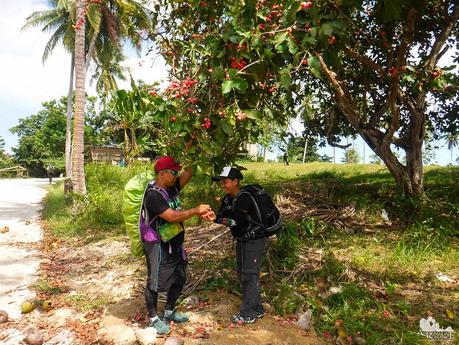
Tambis, or water apples, are common tropical fruit. When ripe, these red bell-shaped fruits have a mild, slightly sweet taste similar to apples. Its moisture content is quite high although not as much as citrus fruits. They taste really good when you dip the fruit in a bit of salt. Children love tambis as they’re tasty, attractive, and crisp.
The bark of the tambis tree can be concocted or ground into a pulp to make herbal medicine.
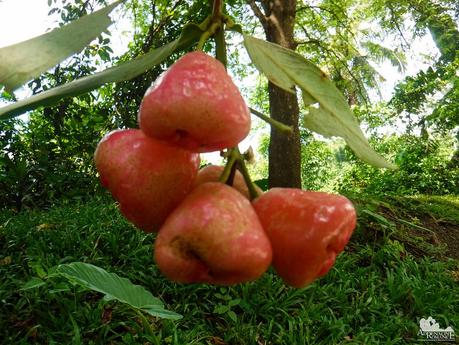
Whew! It was an uncomfortably hot afternoon out here in the open. But at least, walking up on dirt trails and hills gave a much-needed relief to our sore feet. Despite the harsh afternoon sun, the air was refreshing and cool, and we weren’t walking on concrete.
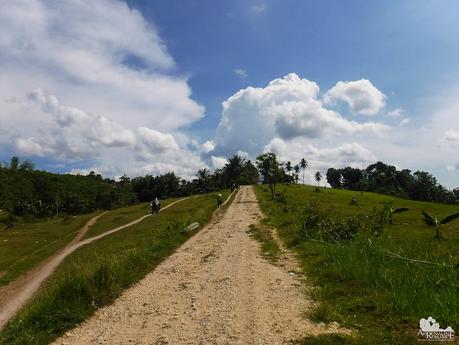
As usual, Sir Jing taught us plant ID, making the trek not only fun but also educational. This plant is a member of the cactus family, and it has medicinal properties.

The hot trek seemed never-ending. Then as we crested a hill, we found what we mutually considered a sight for sore eyes. Hugging a steep mountainside just a mile or two away was a moving, busy line of tiny buses, cars, and trucks. We’ve reached Badian, and beyond us was the highway—and our exit point!
Energized by the sight of the highway, we walked faster on the dirt road. At times, the highway disappeared from our sight, leaving only the soaring, meadow-like mountains of Barili. But the increasing and unmistakable drone of passing vehicles assured us that we were near.
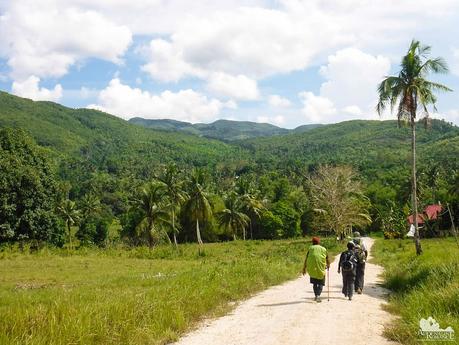
Finally, after 9 hours of trekking through the harsh heat, we finally stumbled half dead towards the Barili public market. Sir Jing shook our hands, signifying that we have successfully finished Segment 2 of the Cebu Highlands Trail! Whoopee!
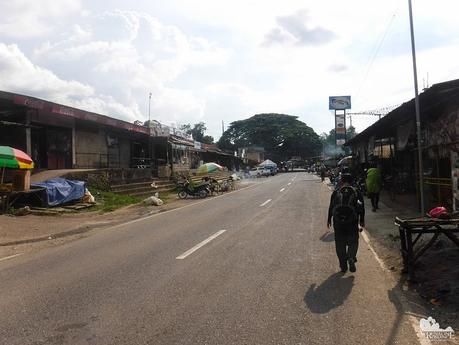
Freshly cooked bibingka (rice and coconut cakes grilled in banana leaves) and ice-cold Coke never tasted so good! It’s a simple but fitting reward for a trek well-done.
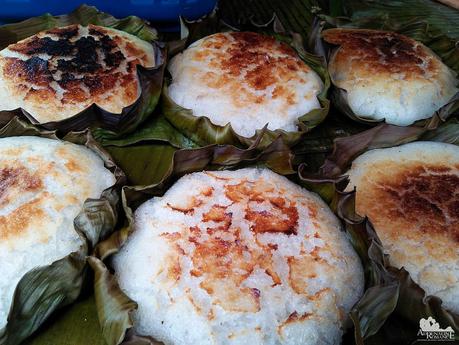
Special Thanks
We would like to thank Jessie of Se7en Outdoor, our sponsor for outdoor apparel, for these amazing trucker caps. They’re incredibly comfortable, giving us a lot of head protection. Thank you too for the extremely cool and sleek Se7en dry-fit shirts.
Thank you to our guide Sir Jing as well as our adventurous and amazing friends Halourd and Apol who accompanied us in this endeavor. It’s always fun to trek with you, guys!
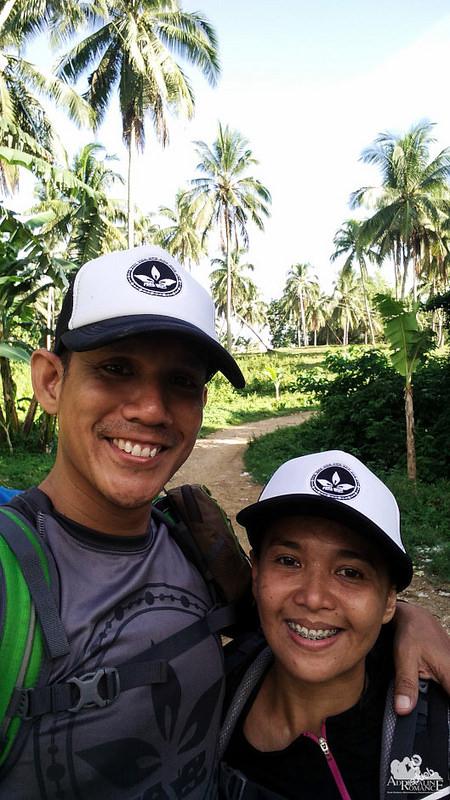
With the completion of Segment 2 of the Cebu Highlands Trail, we have successfully walked over 100 kilometers of rugged terrain, established roads, mountain trails, and waterways. That’s the total length of Segment 1 and Segment 2, making it the longest trek we’ve ever done under our own physical power. Personally, that is quite an achievement for us even though there are still 300 kilometers more to go.
We consider ourselves as ordinary people, but we are definitely not ones that give up easily. As British philosopher Bertrand Russel aptly put it,
“Nothing great achievement is possible without persistent work.”
We persisted, and we achieved.
(Aerial photos courtesy of Halourd)
Links to Earlier Cebu Highlands Trail Segments
- Segment 1A (Part 1)
- Segment 1A (Part 2)
- Segment 1B (Part 1)
- Segment 1B (Part 2)
- Segment 2 (Part 1)
Itinerary
Day 1
5:00 AM – assemble at Cebu South Bus Terminal
5:30 AM – leave Cebu City
7:00 AM – arrive at Lutopan, breakfast, prepare
7:30 AM – start trekking
8:00 AM – arrive at Bunga
10:00 AM – arrive at Lamac, Pinamungahan
12:00 PM – arrive at Bugho, lunch break
1:00 PM – leave Bugho, start trekking to Tubod
3:30 PM – arrival at Tubod
4:30 PM – refresh, prepare dinner, set camp
6:00 PM – dinner
8:00 PM – lights out
Day 2
5:00 AM – wakeup call, prepare breakfast
6:00 AM – breakfast
6:30 AM – break camp
7:00 AM – leave Tubod
12:00 PM – arrive at Calindan, lunch break
1:00 PM – leave Calindan, trek to Barili
3:30 PM – arrive at Barili, snacks
4:30 PM – ride bus back to Cebu
Budget*
- Php 50 per person – bus fare per person, Cebu South Bus Terminal to Lutopan
- Php 70 per person – bus fare per person, Barili Public Market to Cebu South Bus Terminal**
- TBN (to be negotiated) – Sir Jing’s professional guideship fee
* Rates can change without prior notice. Note that we didn’t include the budget for meals, snacks, and personal expenses as you may have different sharing schemes or preferences.
* It can be difficult to hail a Cebu-bound bus from Barili, especially in the afternoon. That’s because buses coming from southern parts of the island are already full by the time they reach Barili. In that case, we recommend you ride a tricycle to Carcar (Php 20 per person). Ask the driver to drop you off at the Ceres bus terminal in Carcar City. Bus fare from Carcar to Cebu South Bus Terminal is around Php 50.
Tips
1. For guideship services, contact Mr. Jing Lavilles de Egurrola at 0933-3225005. You can also get in touch with him through his personal Facebook account and through the Camp Red Facebook Group. He and his partner Jonathan Apurado are the only ones who have completed the CHT.
Please have the courtesy to introduce yourself first when contacting him. Let him know that we referred you to him through our blog.
2. Presently, self-guided hikes on the CHT are not yet possible. The trail is not marked, and you could get easily lost. Moreover, locals are wary of strangers, and visiting their place unannounced can make them suspicious of your presence. This could constitute a misunderstanding or worse, a security issue. It’s mandatory to hire Sir Jing as he will get the necessary permissions and arrange the courtesy visits for you.
3. As of this writing, a guided thru-hike is not yet possible. Until the trail is marked and the Cebu Province supports its protection and documentation, only guided segment/sub-segment hikes can be done.
4. Bring a wide-brimmed hat or scarf to protect yourself from the heat. Don’t hesitate to tell the guide to stop if you feel exhausted.
5. Water sources are aplenty on the trail. You can also buy bottled water and resupply at the sari-sari stores along the way.
6. Wear arm guards and trekking pants to protect your skin from the sun and prickly plants. Also, a dry-fit shirt or rash guard will help keep you cool. Se7en makes very comfortable outdoor apparel.
7. Wear trekking shoes or sandals with an aggressive tread. You will need a lot of traction since you will be scrambling over loose soil and slippery rocks.
8. Bring salt tablets or ion-filled beverages such as Gatorade, coconut water, or fruit juice aside from water. The hot sun, multiple ascents, and exposed trails can make you sweat a lot. When you lose enough ions and salts via your sweat, cramps will occur. If cramps happen, rest for awhile, drink a lot of water or ionic drinks. This will replenish the ions in your system.
9. Bring energy-rich trail food such as nuts, crackers, bread, and bananas. Don’t underestimate the trail.
10. Pack light but do bring the following:
- water (at least 2 liters)
- good-quality 3-season tent with fly sheet and groundsheet (or hammock)
- cookset (can be shared with the group)
- burner (can be shared with the group)
- cold weather gear (warmer, thermal underwear, fleece
- jacket, windbreaker or winter jacket)
- extra clothes (1 set for climbing, 1 set for sleeping, 1 set for returning home)
- trekking shoes/boots and light flip-flops (for walking around the campsite)
- raincoat, rain jacket, or poncho
- hat, scarf, and sunglasses (to protect yourself from the sun)
- first aid kit
- food for dinner, breakfast, and lunch
- hydration salts, table salt, or Gatorade (to avoid and relieve cramps)
- toiletries
- headlamp or flashlight
- whistle
- cellphone
- extra money
- trail snack
- personal medication
11. Don’t forget to waterproof your belongings. You can do this easily by wrapping your stuff inside dry sacks or plastic bags.
12. Please mind your trash; do not leave any of your garbage behind. Keep your voices low, and avoid unruly behavior.

